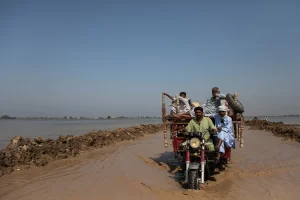Pakistan’s Farmers Are Already Bracing for the Next Disaster
Source: foreignpolicy.com, Date: November 16, 2022
SINDH PROVINCE, Pakistan—Muhammad Umar Jamali’s rice crop in Johi, Pakistan, usually peaks in autumn. In a normal year, he would harvest the rice before December, making way for mustard to grow in the winter. But this year, some of the worst floods in Pakistan’s history wiped out Jamali’s crop and submerged his land, along with that of millions of other farmers. “When the water first started coming, we said it is not a lot, but then it continued to increase and increase,” Jamali said. “And then our seeds were swept away, the seeds we sow.”
Starting in mid-June, heavy monsoon rains caused rivers to spill their banks and inundated southern Pakistan, destroying nearly 80 percent of crops in Sindh province. Farming is the primary means of subsistence for millions of the province’s rural residents—including small landowners, sharecroppers, and day laborers—and Sindh around one-quarter of Pakistan’s agricultural output. Months after the floods, some areas remain partially submerged—the flat landscape and failing water infrastructure leaving stagnant pools of water behind.
The extent of the damage is still coming into view. The World Bank estimates that this year’s flooding has already cost the country more than $30 billion in total damages and economic losses. To stave off further agricultural losses, Pakistan is counting on the harvest of its staple wheat crop, which is planted in the winter and harvested in the spring and early summer. Getting seeds in the ground will be no easy task given the land that remains submerged: In mid-October, more than 4,000 square kilometers of land in Sindh remained underwater.
Even before the floods, farmers in Sindh were on the front lines of Pakistan’s climate crisis. Changing weather patterns—extreme heat and unrelenting monsoon rains—have exacerbated long-standing water access issues as farmers compete for limited irrigation resources. Under normal circumstances, many of the province’s agricultural workers live from hand to mouth, and they were barely scraping by before the floods came this year. With weather extremes only worsening, the loss of a season of crops in Sindh may be a harbinger for future obstacles.
The flooding and its aftermath have stirred long-term concerns about food security in Pakistan. Farmers are struggling under the weight of massive inflation, and many people are falling into debt to buy supplies. Basic food items have become harder to afford; in the parts of Sindh that are still flooded, communities face extra costs to travel to buy fresh food and water. Farmers are also dependent on wheat, the winter crop, to sell and eat: If the floodwaters in Sindh don’t drain fast enough to allow time to plant, the province could face another disaster.
In villages across Sindh, the immediate shocks from a season of lost crops are already being felt; effects of the flooding have pushed some agricultural communities further into poverty. Food inflation in Pakistan reached 36 percent last month compared to the previous year, reflected in the price of staple goods like flour, tea, and fresh vegetables. Facing constraints on all sides, many small landowners and sharecroppers will depend on help from the government to begin planting wheat before it’s too late—a window that usually ends in late November or early December.
The government announced that it would begin distributing seed to farmers in flood-affected areas beginning in early November. “The government of Pakistan is going to provide free seed to all farmers who are affected by floods,” Maj. Gen. Muhammad Zafar Iqbal, the national coordinator of the National Flood Response Coordination Centre, told Foreign Policy. Sindh province is focused on providing cash grants to farmers to purchase their own supplies, and the World Bank has promised the provincial government $323 million to provide subsidies for fertilizer and seeds.
Pakistan’s plan to salvage this year’s wheat crop requires farmers to sow their seeds as soon as possible. The effort to collect and verify data from farmers in remote villages and then provide them with compensation is testing the coordination of provincial and district governments. There are local challenges, such as ensuring that the person who receives government support can prove land ownership, said Abdul Rauf Magsi, who works for Kamber Shadad Kot district’s agriculture extension program.
If farmers can’t get wheat seeds in the ground in time this year, then they say they will plant crops they see as less profitable, such as sunflowers to be used for sunflower oil. The urgency of the government program underscores Pakistan’s heavy reliance on wheat, said Mahmood Nawaz Shah, senior vice president of Sindh Abadgar Board, an advocacy group for progressive farmers in Sindh, and a farmer himself. Demand for wheat is growing along with Pakistan’s population, but domestic yields have decreased due to climate change, water scarcity, and issues with seeds and other inputs. “Our food security paradigm starts and ends with wheat,” Shah said.
Government support offers little to those who already took on debt to buy supplies. Farmers whose land has drained enough to plant wheat or other crops have already started trying. In Bidoo Mugheri village in Kamber Shahdadkot district, a group of sharecroppers gathered to recount their losses, saying they have had to take loans from their landlords to afford seed bags, which they say have increased in price in their area by around 30 percent. Fertilizer and pesticides are also more expensive. “During the three months of devastating rain and flood, we didn’t get any paid work, so now we are under huge debt,” said Haji Tilan Khan Mugheri, 62.
The floods also destroyed fodder used to feed cattle, killing off livestock—another reliable source of income. Women, usually involved in farm work, are now trying to earn money through embroidery, sewing, and other manual labor, said Shazia Mugheri, 20. “When our crops don’t grow well, then we the women also work to help our men,” she said. Anything the sharecroppers earn will only go toward paying off their loans, trapping them in a cycle of debt—a long-standing problem in Sindh that this year’s flooding has only exacerbated.
Pakistan’s government also aims to offset losses to crops in flooded areas by relying on its domestic wheat stocks and increasing imports. This month, it approved a $112 million deal to import 300,000 tons of wheat from Russia. But importing more food also has significant implications: Pakistan is already grappling with balance of payment issues and dwindling foreign reserves, and it has sought support from international donors and the International Monetary Fund to stabilize its economy.
Many farmers in Sindh remain in stasis. At a tea shop along the main highway in Dadu district, small landholders and sharecroppers whose fields are still inundated pass their days in aimless conversation. After last season’s rice crop couldn’t be salvaged, they searched for work in nearby cities or sold building materials from homes that collapsed in their floods. Some farmers have experienced personal losses: Ghulam Qadir Babar, 40, spoke of his 25-year-old brother, Muhammad Bakir, who drowned as the floodwaters rose around him.
On the global stage, Pakistani leaders are pushing for funding for vulnerable countries in the name of climate justice. At the annual United Nations climate change summit in Egypt this month, Islamabad led the charge in calling for a “loss and damage” fund to provide compensation for extreme weather events caused by climate change, such as this year’s flooding. “These are entitlements for countries that are on the front line of somebody else’s carbon legacy,” Sherry Rehman, Pakistan’s climate change minister, told Foreign Policy in October.
As extreme weather events become more common, Pakistan’s water and agricultural systems will need to adapt to prevent further economic damage. In Sindh, climate change is already delaying growing seasons, and heat waves lead to more diseased crops. Meanwhile, small farmers complain that influential landowners further upstream overdraw from shared irrigation canals. Jamali said only around one-third of the land in his area is even used for growing wheat under normal circumstances because there is not enough water.
Jamali and his neighbors have slowly started moving back to the homes they evacuated, but they are still waiting for their land to drain completely. He said relying on high-interest loans to buy supplies was the only option for many of his neighbors. “The wheat is gone, our houses are gone too, [and] our beds are also gone,” Jamali said, describing the conditions in his area. He and millions of others like him remain powerless as the floodwaters linger.
Hanif Imam contributed to this story.







